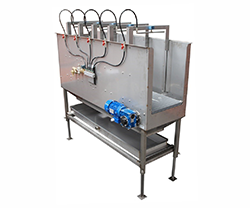Understanding Greenhouse Irrigation
Greenhouse irrigation involves various techniques designed to provide plants with the water they need to thrive. Given the controlled nature of greenhouses, irrigation systems must be precise, adaptable, and efficient. The primary goals are to ensure uniform water distribution, avoid waterlogging, and reduce water usage.
Types of Greenhouse Irrigation Systems
Drip Irrigation Drip irrigation is one of the most efficient methods for greenhouse watering. It involves a network of tubes and emitters that deliver water directly to the plant roots. This system minimizes evaporation and runoff, ensuring that plants receive the precise amount of water needed. Drip irrigation is ideal for a variety of crops and can be easily automated to maintain consistent moisture levels.
Overhead Sprinklers Overhead sprinkler systems distribute water from above, simulating natural rainfall. While effective for a wide range of crops, these systems can lead to higher water usage and increased humidity levels within the greenhouse. They are best suited for large-scale operations and crops that are less sensitive to leaf wetness.
Misting Systems Misting systems release fine droplets of water into the air, creating a humid environment. This method is particularly beneficial for seedlings and delicate plants that require high humidity. However, misting can increase the risk of fungal diseases if not properly managed.
Capillary Mats Capillary mats are absorbent materials placed beneath pots or trays. They draw water from a reservoir and deliver it to the plants through capillary action. This method ensures even moisture distribution and reduces the risk of overwatering. Capillary mats are ideal for small to medium-sized greenhouses and can be used in combination with other irrigation systems.
Benefits of Efficient Greenhouse Irrigation
Water Conservation Efficient irrigation systems significantly reduce water usage by delivering water directly to the plant roots and minimizing evaporation and runoff. This is particularly important in regions with limited water resources.
Enhanced Plant Health Consistent and precise watering promotes healthy root development and prevents stress caused by water fluctuations. This leads to stronger, Greenhouse Controller more resilient plants and higher yields.
Cost Savings By reducing water waste and optimizing resource use, efficient irrigation systems can lower operational costs. Automated systems also reduce labor costs associated with manual watering.
Improved Disease Management Proper irrigation reduces the risk of waterborne diseases and fungal infections by maintaining optimal moisture levels. Systems like drip irrigation and capillary mats keep foliage dry, which is crucial for disease prevention.
Best Practices for Greenhouse Irrigation
Regular Monitoring Regularly check irrigation systems for leaks, blockages, and wear. Ensure that emitters and sprinklers are functioning correctly to maintain uniform water distribution.
Soil Moisture Management Use soil moisture sensors to monitor moisture levels and adjust irrigation schedules accordingly. This prevents overwatering and ensures that plants receive the right amount of water.
System Automation Automating irrigation systems with timers and sensors can significantly improve efficiency. Automated systems ensure consistent watering and reduce the risk of human error.
Water Quality Use clean, filtered water to prevent clogging of irrigation systems and reduce the risk of introducing pathogens to the greenhouse environment.






Comments